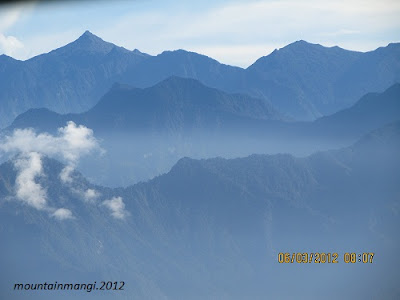I was surprised when I first saw "blue", instead of white head plumes of the King of Saxony bird of
Paradise on one of the traditional dance groups' head dresses. I noticed that while
going around with another colleague,(Ben Ruli) interviewing traditional dance groups on
their traditional costumes (especially bird feathers, animal skin and fur) they were using. This year was my third to be
involved in a Traditional Bilas Survey that the Papua New Guinea Institute of Biological Research does at the annual Goroka Cultural Show. It was really interesting to see that some cultural groups
are turning to artificially modified objects to portray animal parts and are
using it as a supplement for real animal parts in traditional cultural costumes.
 Among others, the one that caught my attention was the head plume of the King
of Saxony bird of paradise (Pteridophora
alberti). When I first saw it, It looked weird because it was blue. I taught
waoooh..! This people must be using a head plume of a new King of Saxony
species. Being attracted, I went over
for a closer inspection, and found out that it was an artificial one. Plastic
sheets were cut out to resemble the head plume and used on their head dresses.
Among others, the one that caught my attention was the head plume of the King
of Saxony bird of paradise (Pteridophora
alberti). When I first saw it, It looked weird because it was blue. I taught
waoooh..! This people must be using a head plume of a new King of Saxony
species. Being attracted, I went over
for a closer inspection, and found out that it was an artificial one. Plastic
sheets were cut out to resemble the head plume and used on their head dresses.
 Among others, the one that caught my attention was the head plume of the King
of Saxony bird of paradise (Pteridophora
alberti). When I first saw it, It looked weird because it was blue. I taught
waoooh..! This people must be using a head plume of a new King of Saxony
species. Being attracted, I went over
for a closer inspection, and found out that it was an artificial one. Plastic
sheets were cut out to resemble the head plume and used on their head dresses.
Among others, the one that caught my attention was the head plume of the King
of Saxony bird of paradise (Pteridophora
alberti). When I first saw it, It looked weird because it was blue. I taught
waoooh..! This people must be using a head plume of a new King of Saxony
species. Being attracted, I went over
for a closer inspection, and found out that it was an artificial one. Plastic
sheets were cut out to resemble the head plume and used on their head dresses. It may relay messages that the bird is becoming difficult to hunt for their head plumes or people do not want to kill the birds and so are resorting to such techniques.
This practise may be bad for our traditional cultures as it
is devaluing its originality and pride. However, it is good for conservation as
the King of Saxony Birds of Paradise won’t be heavily hunted for their head
plumes. The artificial plumes are resistible to insect attack and can be kept and
used for longer period of time.
This practise is in itself a new information or idea to
people like me working to do research on and conserve the biodiversity. Sitting
here writing this, I am thinking…. “It will be good if we can make artificial
animal parts for people to use during cultural dances and events so that they
do not go hunting to get traditional costumes. This will give time for the
wanted population in the wild to replenish.”
